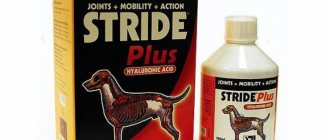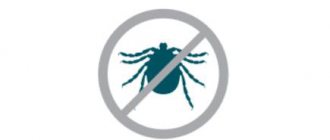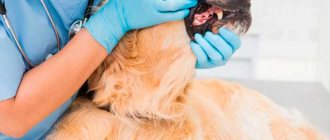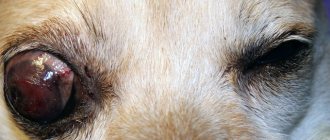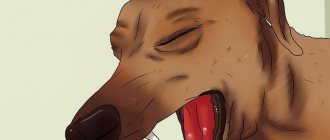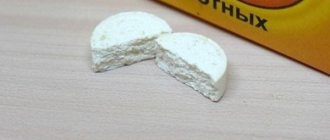Why arthritis may develop
Joint disease is characterized by the fact that the localization of inflammation cannot be cured. Thanks to timely medical care, it is possible to relieve pain and restore mobility to the affected limbs.
Concomitant factors that provoke this disease include:
- age of the animal - the older the pet, the less elastic the cartilage tissue of its limbs;
- genetic predisposition to the disease;
- dog passivity;
- congenital or acquired pathology of a limb;
- infectious infection;
- autoimmune reaction.
If arthritis in a dog is not treated, a complication of the disease may be amputation of a limb, paralysis and subsequent death of the pet from intoxication of the body.
Causes
Among the reasons for the occurrence of a dangerous condition for a dog are the following factors:
- congenital pathology of the structure of bone or cartilage tissue, for example, dysplasia;
- infectious diseases and autoimmune responses in response to inflammation;
- genetic predisposition, especially in small breeds of dogs;
- reduced motor activity due to the nature of the pet, the so-called “phlegmatic” type;
- age-related features, when the aging process affects the elasticity of cartilage tissue and joint capsule;
- excess weight due to overeating, a tendency to obesity, diabetes;
- mechanical damage, injuries (dislocations of joints, sprained muscles, ligaments).
Symptoms of arthritis in an animal
The first and most important sign of arthritis is a sharp decrease in the pet’s activity. The affected joint swells, increases in size and turns red. When touching a sore spot, the dog becomes irritated.
Over the next few days, other symptoms of arthritis appear:
- fatigue and weakness in overcoming distances - the animal rests more often and constantly lies on one side;
- moves very slowly and carefully, limps awkwardly, tries not to step on the injured paw;
- when touching a swollen joint, the pet shows aggression;
- if the hind limbs are affected, the dog does not bend them when moving;
- refuses walks and food;
- the animal reacts to weather changes - sleeps poorly, whines and lies down.
A timely visit to the veterinarian will save the dog from complications of the disease. The more time passes from the onset of symptoms, the less likely there is to subsequently restore the functionality of the limb.
First symptoms
Signs of developing arthritis in pets:
- The most obvious symptom is an increase in joint volume. This can only be detected on the paws, as this is where it is most noticeable.
- Joint immobility. Due to edema, motor ability is impaired.
- Painful sensations. Every movement that affects the inflamed joint causes incredible pain to the dog.
- Constant desire to relax. The animal tries to lie on the healthy side. With bilateral inflammation, an unnatural posture is adopted so as not to hurt the joints.
- Decreased activity. The dog does not want to take long walks, runs, or jumps. He has difficulty walking up stairs, jumping, or getting down from a chair.
- Tendency to gain weight with decreased appetite. This happens due to a decrease in walking time and physical activity.
Types of Arthritis in Dogs
Depending on the history, the type of arthritis is divided into main types.
Traumatic arthritis
Occurs as a consequence of a sprain, blow or fracture. Mechanical stress disrupts the integrity of cartilage tissue, thereby triggering the process of degeneration.
Functional arthritis
Occurs due to excessive load on cartilage. This leads to metabolic disorders and subsequent destruction of the joint. The inflammatory process is formed from bone friction.
Dystrophic or metabolic arthritis
The main reason for the occurrence is a failure in the metabolic processes of the animal’s body. During the synthesis of pyrophosphate cells that form cartilage, calcium crystallization occurs, fractions of which are deposited in the synovial canals and provoke the development of the inflammatory process.
Treatment of dystrophic (metabolic) arthritis in a dog must begin with eliminating the causes of metabolic disorders.
Purulent (infectious) arthritis
The disease develops due to infection of cartilage tissue through an open wound or damaged area of skin. The main pathogens of purulent etiology are staphylococci or streptococci. Similar to rheumatoid arthritis, where bacteria destroy healthy cartilage and bone cells.
The disease is very dangerous for the pet's health. In the later stages of development, purulent arthritis often transforms into deep fistulous lesions, which threatens limb amputation or blood poisoning.
Genetic arthritis
An innate tendency to joint diseases is transmitted genetically. One of the main causes of the disease is hip dysplasia of one of the parents. Ultrasound shows severe depletion of the cartilage tissue connecting the femoral head and acetabulum. When friction occurs, the area of damaged cells becomes inflamed. Experts associate this anomaly with a lack of minerals in the dog’s body, which leads to pathological changes from minimal physical activity.
Treatment methods
In case of inflammatory lesions of the joints, adequate therapeutic therapy and a treatment regimen are selected by the attending veterinarian, having in hand the results of a diagnostic examination. The choice of methods depends on the form, stage of the disease, the health status of the pet, the physiological characteristics of the body, and the root cause.
In the initial stages of the development of arthritis and synovitis, following the recommendations of the attending physician, treatment can be carried out at home.
Treatment of joint inflammation in dogs involves complex symptomatic therapy. Patients are prescribed systemic, anti-inflammatory, analgesic, decongestant, antibacterial medications for local and general treatment . Therapeutic therapy is aimed at relieving the inflammatory process and normalizing the function of the affected joint.
Important! For purulent inflammation of the joints, physiotherapeutic techniques, alternative medicine, homeopathic medicines (Hondatron), and complex mineral and vitamin complexes can be additionally prescribed.
Local treatment involves the use of cold, warming compresses, medicinal ointments, creams, liniments, and pressure fixing bandages.
When the first symptoms of inflammatory diseases of the joint appear, it is necessary to reduce physical activity. Dogs are prescribed Prezocil. Give one tablet three times a day. Warm paraffin or ozokerite is applied to the inflamed joint. The affected area is heated with a Minin lamp. Physiotherapeutic techniques should be alternated with light massage. Circular novocaine blockades and tissue therapy are effective. A warming compress based on 50% dimexide and 0.5-1% novocaine is applied to the articular surface.
At the initial stages of the development of inflammation in the joints, Quadrisol-5 helps well. Contains a new generation non-steroidal component. The drug has an anti-inflammatory effect and relieves severe pain. If purulent fistulas have formed around the joint, it is necessary to remove the hair and lubricate the skin with iodine infusion.
In the treatment of arthritis, Hondratron, Chondroitin sulfate, and Dexafort are used - a complex of glucocorticosteroids for intramuscular injection. To relieve pain symptoms, Traumeel is prescribed by injection. Injections, depending on the intensity of the pain symptom, are given once or twice a day.
For synovitis, novocaine blockades (novacaine with an antibiotic) are indicated. First, cold compresses are used, followed by warming procedures. After treatment, animals are prescribed restorative therapy.
If a pet suffers from osteoarthritis, veterinarians use the injectable drug Chionate based on sodium hyaluronate in treatment. After the first injection, the condition of the sick dog noticeably improves. Administered intra-articularly, intravenously. The homeopathic medicine “Tsel”, “Discus Compositum” can also be prescribed.
For arthritis and osteoarthritis, surgical treatment is most often used, since conservative methods do not give the desired result. After opening, exudate and fibrin clots are removed from the joint cavity. The cavity is washed with ethacridine lactate, furatsilin, antiseptic solutions, antibiotics. The capsule is partially or completely sutured. After the operation, suction and immobilizing bandages are applied. Four-fingered patients are prescribed complex antibiotics, nitrofurans, sulfonamide drugs, and diuretics to relieve swelling.
Important! If your dog is scheduled for surgery, physical activity should be limited. Do not allow your pet to become hypothermic. In wet weather and cold seasons, walks should be short. Keep your dog warm.
In case of diseases of the musculoskeletal system, chronic pathologies prone to recurrence, intense physical activity is contraindicated for dogs . It is very important to constantly monitor the condition of your beloved pet and provide adequate nutrition (protein, vitamin and mineral diet).
Diagnostic methods in dogs
Diagnosis of the disease in a pet is carried out through a comprehensive step-by-step examination.
- Initial examination and history taking. The visual condition of the animal is assessed, the location of the lesion, the degree of muscle tone and tendon location, the localization of swelling are examined by palpation, and body temperature is measured.
- Radiography. The picture is taken in a 4-sided projection for an objective assessment of possible locations of intra-articular free substances. At this stage, the degree of deformation of the cartilage tissue in thickness and size is also determined.
- Computed tomography of the joint. It is mainly prescribed when another etiology of the disease is suspected. In case of hip dysplasia, examination is mandatory.
- Clinical data. Collection and laboratory processing of synovial fluid excludes or confirms bacterial infection of cartilage tissue.
- Histological or cytological examination. Prescribed for suspected atypical cell proliferation.
What should owners of a dog suffering from arthritis do?
First of all, begin active conservative therapy in order to prevent further development of the inflammatory process. In mild stages of the disease, the dog will be helped by herbal decoctions and oily compresses.
- A decoction of nettle and chamomile has an anti-inflammatory effect and quickly relieves pain and swelling. Take 20 grams of the mixture per glass of boiling water, keep on low heat for 15 minutes, let cool. Taken orally 20 ml 3 times a day.
- Dilute 2 drops of lavender and juniper oils in a glass of water. Soak the fabric with the product and apply to the sore spot for 20 minutes. The compress should be done daily.
To alleviate the condition of a sick pet, you need to adjust the diet, excluding from it foods that contribute to excess weight gain.
Injuries
There are the following types of injuries:
- wounds;
- sprains;
- dislocations.
Wounds
Incised wounds are covered with scab and heal well if the conditionally pathogenic microflora does not penetrate into the joint. The animal needs rest. If the defect is extensive, stitches are applied. Protect the wound from secondary infection. When suppuration develops, antibiotic therapy is used locally, in the form of powders.
Puncture wounds are more difficult to treat. Their consequence is purulent arthritis if the pathogenic microflora enters anaerobic conditions.
Sprains
Distortion (stretching) occurs during sudden jumps, pinching, or being hit by a car. The following symptoms appear the next day:
- lameness;
- soreness;
- the joint is swollen, painful;
- the dog does not lean on its paw, holds it in a half-bent position;
Treatment: a tight bandage is applied and hydrocortisone is injected intramuscularly.
Lameness
Dislocations
The following types of dislocations are distinguished:
- complete, bones completely lose contact;
- subluxation, contact preserved;
- simple, the skin is not damaged;
- open, joint bones exposed;
- congenital, affects mainly puppies;
- familiar.
The pathology is characterized by limited and painful movements. Treatment consists of reduction with local or systemic anesthesia. A bandage is applied that restricts movement for 10–14 days.
Treatment of arthritis in dogs
To treat a sick pet, an integrated approach is used with the aim of multifaceted effects on the foci of inflammation in order to bring the disease into remission.
Conservative course of treatment
The course of treatment for the disease includes:
- Stop arthritis. A complex medicine of the chondoprotective class with an anti-inflammatory effect. Promotes the regeneration of cartilage tissue, stimulates metabolic processes and restores shock absorption of the joint.
- Arthroglycan. Activates restoration processes by normalizing metabolism in cartilage tissue cells, provides mineral saturation, which prevents the development of hip dysplasia.
- Gel “Horsepower” for joints. Warms the affected area, thereby providing mobility and reducing pain. The active phenoxyethanol and glycerin it contains provide additional antibacterial protection to the affected area.
- Ketofen. The medicine has a good analgesic effect and is used to relieve acute pain. Not prescribed for dogs with kidney problems.
- Rimadyl. Anti-inflammatory and analgesic. Used for severe forms of arthritis.
- Stride Plus. A drug from the line of chondroprotectors. Improves joint mobility, reduces pain and swelling, and relieves inflammation.
- Prednisolone. A hormonal medicine used cautiously in the treatment of arthritis. It relieves inflammation well and quickly, but at the same time suppresses the body’s immune system. Prescribed strictly under the supervision of a veterinarian.
What and how to treat a dog for arthritis should only be prescribed by a veterinarian. Do not self-medicate, this can be dangerous for your pet's health.
Surgery
In addition to medication options, if there are medical indications and an assessment of the dog’s current condition, surgical treatment is carried out.
- Joint replacement. The diseased joint is surgically replaced with an artificial one made of metal. This is an expensive operation that is performed in specialized clinics. Currently, modern joint replacement technologies are only available for large breed dogs.
- Joint amputation. It is carried out for medical reasons when cartilage tissue is completely destroyed or there is a risk of blood poisoning.
The decision on surgical intervention is made by the veterinarian based on the collection of current data on the dog’s condition, the severity of the inflammatory process and an assessment of the possible development of complications.
After surgery, the animal requires a long recovery period at home. The intake and distribution of medications during the postoperative period should be strictly controlled by a veterinarian. If the pet is not provided with a recovery period, surgery for arthritis in a dog can lead to complications in the form of chronic or acute development of the disease.
Diet and physiotherapeutic treatment
For more effective treatment of any joint disease in dogs, a special diet is prescribed. The diet should not contain dry food containing large amounts of carbohydrates and starch. It is also necessary to exclude cereals and potatoes from the diet, since such products can provoke an exacerbation of the existing disease. It is important to diversify the dog’s menu with cartilage, greens and fatty fish. You should not feed a sick animal fatty meats, which include pork. It is better to give preference to beef and poultry.
Physiotherapeutic treatment is widely used in the fight against this disease. For example, massage improves blood circulation in the affected limb, reduces pain, relaxes muscles, and promotes the resorption of exudate in the joints.
To stimulate restoration processes in cartilage tissue, heating is used. This procedure has a beneficial effect on the ligaments of the joints, thereby increasing their elasticity and improving mobility.
Preventive measures
The development of the disease can be avoided by adhering to the general rules of behavior with a dog:
- on walks, try not to overload the animal with physical activity;
- equip a soft and warm corner for the dog at home;
- adhere to the diet recommended by your veterinarian for your pet;
- if the dog is predisposed to the disease, in consultation with the veterinarian, include chondroprotectors in the diet;
- for preventive purposes, give the animal regular massage sessions;
- Monitor your dog’s health and promptly visit a doctor if necessary.
How is the diagnosis carried out?
The dog usually shows no signs of pain. Therefore, the owner is the only one who can understand that his pet needs help. This applies not only to the appearance of the joint, but also to the animal’s activity level, gait and other symptoms.
To diagnose, the doctor will perform blood and urine tests. This will help identify the presence or absence of a bacterial cause of the disease. Then he will assign:
- X-ray;
- computed tomography;
- collection of joint fluid.
Did you know? A 2010 study from Brazil found that bee venom actually reduced the symptoms of rheumatoid arthritis.
This allows you to identify any signs of bone damage. So, on an x-ray you can notice all age-related features and tissue changes. And computed tomography allows you to obtain a 3D model of the joint.
Based on the results of the examination, treatment is prescribed. If veterinary care is unavailable for some reason, arthritis is a condition that can be successfully treated at home. The main thing is to relieve pain in the joint, ensure proper nutrition and physical activity.
Care
A pet suffering from this disease needs special care. To support the animal and minimize the risk of complications, you need to follow simple rules for caring for it.
- Replace long walks with shorter ones, with frequent rest.
- Keep the animal in a warm place.
- Place the dog on a thick layer of bedding. For example, an old children's mattress is suitable for a large pet.
- Cover the smooth surface of the floor with a rough carpet so that the dog is not afraid of slipping.
- Avoid walking your dog on stairs and steps. If there is a need to cover such a distance, it is better to take your pet in your arms.
- Regular swimming relieves pain; if possible, you can place water procedures with the animal.
- Perform daily massage of the sore limb. This procedure reduces pain and relieves swelling.
It is important to remember that it is impossible to cure arthritis in a dog. It is in your power to alleviate your pet’s suffering and provide him with good care in order to quickly stop the inflammation and restore the mobility of sore joints.
To prevent the latent development of complications after an illness, the dog must undergo a preventive examination by a veterinarian at least 2 times a year.
General recommendations to make your pet's life easier
A dog suffering from arthritis needs special care and attention. To normalize her condition, you should adhere to a number of mandatory recommendations.
- Give up long walks, replacing them with more frequent but shorter ones.
- Keep the animal warm at all times.
- The sleeping area should be thick enough; the individual should not be left on thin bedding. In this regard, children's mattresses are especially good for large dog breeds.
- All smooth surfaces on which the pet walks should be covered with carpets or replaced with a rougher one.
- It is impossible for a sick pet to climb steps and stairs, this will lead to an aggravation and worsening of its condition. You should use the elevator or carry the patient in your arms.
- If possible, provide your dog with regular swimming sessions; simply keeping him in the water can help relieve pain.
- Massage the sore limb, this will relieve tension and swelling.
If the dog is sick, it is better to use the elevator when going to the upper floors
Attention! During the cold season, it is necessary to put warm clothes on the animal and make sure that it does not become hypothermic. Cold worsens arthritis pain and accelerates joint destruction.
